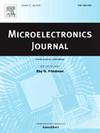A 10-bit 4 GS/s Pipelined-SAR ADC based on loop-unrolled and partial-interleaving
IF 1.9
3区 工程技术
Q3 ENGINEERING, ELECTRICAL & ELECTRONIC
引用次数: 0
Abstract
This paper presents a 4 GS/s 10-bit pipelined-SAR ADC that integrates loop-unrolled (LU) and partial-interleaving (PI) techniques. In the first stage, the LU SAR ADC quantizes the initial 3 bits, enabling a high-speed and efficient quantization process. The residue voltage is then sampled through passive residue transfer and amplified by a two-stage inverter-based residue amplifier, achieving almost 66 % speed enhancement by allowing the first-stage ADC to operate in parallel with the interstage amplifier. The amplified residue voltage is subsequently quantized by the second stage, which consists of a 4-channel time-interleaved SAR ADC, to generate the remaining 8-bit digital code. Post-simulation results demonstrate an SNDR of 57.4 dB and an SFDR of 70.63 dB at the Nyquist frequency.
一种基于环展开和部分交错的10位4gs /s管道sar ADC
本文提出了一种集成环展开(LU)和部分交错(PI)技术的4gs /s 10位流水线sar ADC。在第一阶段,lusar ADC量化初始3位,实现高速高效的量化过程。然后,通过无源剩余转移对剩余电压进行采样,并通过基于两级逆变器的剩余放大器进行放大,通过允许第一级ADC与级间放大器并行工作,实现近66%的速度提升。放大后的剩余电压随后由由4通道时间交错SAR ADC组成的第二阶段量化,以生成剩余的8位数字代码。后仿真结果表明,在奈奎斯特频率下,SNDR为57.4 dB, SFDR为70.63 dB。
本文章由计算机程序翻译,如有差异,请以英文原文为准。
求助全文
约1分钟内获得全文
求助全文
来源期刊

Microelectronics Journal
工程技术-工程:电子与电气
CiteScore
4.00
自引率
27.30%
发文量
222
审稿时长
43 days
期刊介绍:
Published since 1969, the Microelectronics Journal is an international forum for the dissemination of research and applications of microelectronic systems, circuits, and emerging technologies. Papers published in the Microelectronics Journal have undergone peer review to ensure originality, relevance, and timeliness. The journal thus provides a worldwide, regular, and comprehensive update on microelectronic circuits and systems.
The Microelectronics Journal invites papers describing significant research and applications in all of the areas listed below. Comprehensive review/survey papers covering recent developments will also be considered. The Microelectronics Journal covers circuits and systems. This topic includes but is not limited to: Analog, digital, mixed, and RF circuits and related design methodologies; Logic, architectural, and system level synthesis; Testing, design for testability, built-in self-test; Area, power, and thermal analysis and design; Mixed-domain simulation and design; Embedded systems; Non-von Neumann computing and related technologies and circuits; Design and test of high complexity systems integration; SoC, NoC, SIP, and NIP design and test; 3-D integration design and analysis; Emerging device technologies and circuits, such as FinFETs, SETs, spintronics, SFQ, MTJ, etc.
Application aspects such as signal and image processing including circuits for cryptography, sensors, and actuators including sensor networks, reliability and quality issues, and economic models are also welcome.
 求助内容:
求助内容: 应助结果提醒方式:
应助结果提醒方式:


